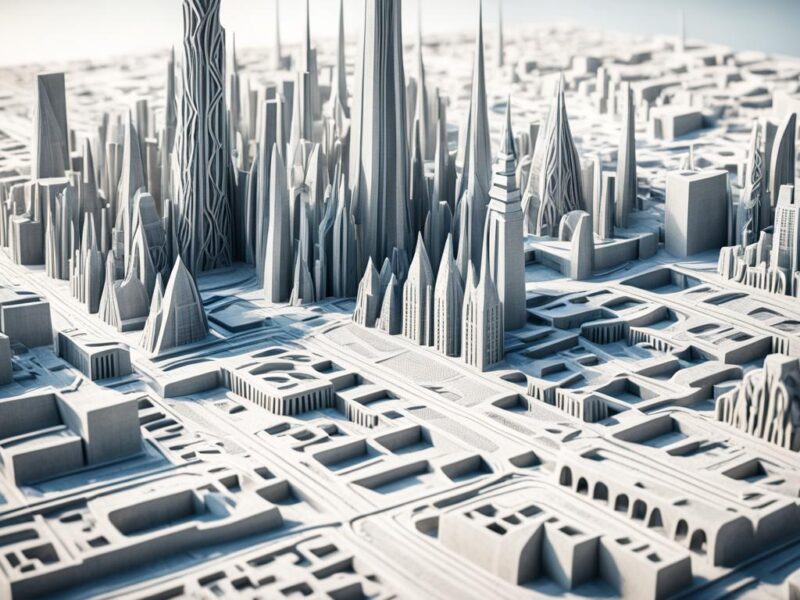
Building for Resilience: 3D Printed Structures and Natural Disasters
Disasters, whether caused by nature or human factors, can have devastating impacts on communities. The need for innovative and efficient solutions to mitigate these challenges has led to the emergence of 3D printing technology. 3D printing, also known as additive manufacturing, enables the creation of three-dimensional objects by layering materials such as plastic, metal, or concrete. It offers a multitude of applications in disaster management, including the development of on-demand supply chains, customized solutions, rapid prototyping, and the use of sustainable building materials.
Incorporating 3D printing into disaster preparedness strategies is revolutionizing the way we approach and recover from disasters. It allows for the rapid production of essential supplies, such as medical equipment and emergency shelters, directly on-site, eliminating the delays associated with traditional procurement processes. With its flexibility and customization capabilities, 3D printing empowers local communities to take charge of their own resilience, reducing their dependence on external support.
This article explores the power of 3D printing in disaster preparedness and recovery efforts. We will delve into its applications in various stages of disaster management, from rapid prototyping and testing to minimizing waste and environmental impact. Real-world implementations and the future potential of 3D printing in disaster recovery will also be discussed, highlighting the benefits and possibilities this technology brings to building more resilient communities.
Key Takeaways:
- 3D printing technology, or additive manufacturing, offers efficient and customizable solutions for disaster preparedness and recovery efforts.
- It enables the on-site production of essential supplies, reducing dependency on traditional procurement processes.
- 3D printing promotes sustainability by minimizing waste and utilizing sustainable building materials.
- Local communities can be empowered through 3D printing, enhancing their resilience and reducing external support.
- The future of 3D printing in disaster recovery holds great potential for remote printing and specialized equipment production.
The Power of 3D Printing in Disaster Preparedness
In disaster situations, traditional supply chains often struggle to meet the immediate demands of affected areas. However, with 3D printing, response teams can quickly produce essential supplies like medical equipment, emergency shelters, and spare parts on-site, eliminating the need for lengthy procurement processes. This on-demand supply chain capability allows for a faster and more efficient response to disaster-stricken areas. Additionally, 3D printing enables the production of customized solutions tailored to the specific requirements of the affected community. This flexibility enhances the efficiency and effectiveness of disaster relief operations.
Benefits of 3D Printing in Disaster Preparedness:
- Rapid production of essential supplies
- Elimination of lengthy procurement processes
- Customized solutions for specific community needs
- Faster and more efficient response to disasters
- Increased resilience and preparedness
“With 3D printing, response teams can quickly produce essential supplies on-site, eliminating the need for lengthy procurement processes.”
Real-world Examples:
| Organization | Application | Location |
|---|---|---|
| Red Cross | Production of medical supplies | Global |
| Field Ready | Manufacturing of spare parts and water filters | Haiti |
Rapid Prototyping and Testing
In the field of disaster management, prototyping and testing new designs before mass production is a critical step in ensuring efficient and effective disaster response. Traditionally, this process involves lengthy and costly manufacturing methods. However, with the advent of 3D printing technology, rapid prototyping has become increasingly accessible and beneficial.
3D printing allows officials to iterate and refine prototypes at an accelerated pace, significantly reducing the time and cost associated with traditional manufacturing methods. This capability enables disaster management teams to quickly develop innovative designs that address specific challenges faced during emergencies.
By utilizing 3D printing technology, officials can readily create multiple prototypes and fine-tune their designs until they achieve optimal functionality. This iterative process facilitates continuous improvement and ensures that the final products are tailored to the unique requirements of disaster situations. The ability to quickly modify and refine prototypes through 3D printing enhances the overall readiness and resilience of communities in the face of disasters.
“3D printing technology accelerates the prototyping and testing phase in disaster management, allowing officials to swiftly refine designs and improve the effectiveness of emergency response plans.” – Disaster Management Expert
Moreover, 3D printing opens up opportunities for greater customization. By rapidly producing prototypes, disaster management teams can evaluate the viability and suitability of different design options before committing to large-scale production. This tailored approach ensures that the final products meet specific needs and requirements, optimizing their impact during disaster scenarios.
Benefits of Rapid Prototyping and Testing in Disaster Management:
- Accelerates the development of innovative designs
- Reduces time and costs associated with traditional manufacturing methods
- Facilitates continuous improvement and refinement of prototypes
- Enhances customization for specific disaster scenarios
- Ensures optimal functionality and effectiveness
By leveraging the power of rapid prototyping through 3D printing, disaster management teams can significantly enhance their ability to respond quickly and effectively to emergencies. The ability to iterate and refine prototypes efficiently enables the deployment of tailored solutions that address the unique challenges posed by disasters, ultimately contributing to more resilient and safer communities.
Minimizing Waste and Environmental Impact
Conventional manufacturing processes often result in excess material waste. However, 3D printing offers an innovative and environmentally-friendly option for disaster response by minimizing waste and promoting efficient material usage.
Unlike traditional manufacturing methods where excess materials are often discarded, 3D printing uses only the required amount of material to create objects. This reduces waste and ensures that resources are used more efficiently, making 3D printing a sustainable choice for disaster relief efforts.
By minimizing waste, 3D printing helps to address the environmental impact of manufacturing processes. Less material waste means less strain on natural resources and a reduced carbon footprint.
Furthermore, 3D printing allows for the use of recycled or biodegradable materials, contributing to a circular economy and further reducing the environmental impact of disaster response.
Overall, the adoption of 3D printing in disaster response not only enables rapid prototyping and customized solutions but also promotes waste reduction and sustainable practices, making it a valuable tool for building a more resilient and environmentally-conscious future.
| Benefits of 3D Printing in Waste Reduction | Environmental Impact |
|---|---|
| Minimizes material waste by using only the required amount of material | Reduces strain on natural resources |
| Enables the use of recycled or biodegradable materials | Contributes to a circular economy |
| Reduces carbon footprint by promoting efficient material usage | Supports sustainability efforts in disaster response |
Empowering Local Communities Through 3D Printing
As accessibility and affordability of 3D printers continue to improve, local communities are now able to take charge of their own disaster resilience. By equipping communities with 3D printers, they gain the ability to produce essential supplies independently, reducing their dependence on external support. This empowerment gives communities greater control over their own resilience and recovery processes, ultimately building stronger and more resilient communities.
3D printers have become more accessible and affordable, allowing local communities to harness the power of this innovative technology. With the ability to create on-demand solutions, communities can quickly respond to disaster situations by producing necessary supplies right at their locations. This eliminates the delays and logistical challenges often associated with traditional supply chains.
The affordability of 3D printers also means that communities with limited resources can still access this technology. By enabling local production of essential supplies, 3D printing promotes self-sufficiency and reduces the financial burden of relying on external assistance. This financial freedom empowers communities to allocate their resources strategically, further enhancing their disaster resilience.
“By equipping communities with 3D printers, we are empowering them to become more self-reliant during disasters. They can now produce the supplies they need, when they need them, without having to rely solely on external support.”
The accessibility and affordability of 3D printers also foster innovation and creativity within local communities. By having direct access to this technology, community members can experiment and develop customized solutions tailored to their specific needs. This flexibility not only enhances the efficiency of disaster response efforts but also encourages continuous improvement and adaptation to changing circumstances.
Furthermore, the use of 3D printers in disaster resilience builds social cohesion and community engagement. Local members can actively participate in the designing and production process, fostering a sense of ownership and pride in their own resilience efforts. This collective effort strengthens social ties and promotes a shared responsibility for building disaster-resistant communities.
Through the empowerment of local communities, 3D printing technology plays a vital role in enhancing disaster resilience. By providing accessibility, affordability, and the opportunity for self-reliance, communities are better equipped to face the challenges of disasters and build a more robust future.

Real-World Implementations
Several organizations and countries have already recognized the potential of 3D printing in disaster preparedness and are actively incorporating it into their response strategies.
For example, the Red Cross has utilized 3D printing technology in collaboration with field hospitals and local partners to produce medical supplies, including prosthetics, orthotics, and surgical instruments, in disaster-stricken areas.
Red Cross and Field Hospitals Collaboration
“The use of 3D printing technology in disaster relief has significantly improved our ability to provide critical medical supplies to those in need,” said Dr. Elizabeth Johnson, Chief Medical Officer at the Red Cross. “By partnering with field hospitals and local organizations, we have been able to produce prosthetics, orthotics, and surgical instruments on-site, ensuring that patients receive the care they require without delays.”
In addition to the Red Cross, organizations like Field Ready have established local 3D printing hubs in countries like Haiti. These hubs enable communities to produce essential items such as water filters and spare parts using recycled materials.
Field Ready in Haiti
“Our 3D printing hub in Haiti has been instrumental in providing communities with access to much-needed water filters and spare parts,” said Mark Jacobs, CEO of Field Ready. “By leveraging 3D printing technology and local resources, we are empowering communities to become self-reliant and resilient in the face of disasters.”
These real-world implementations demonstrate the practicality and effectiveness of 3D printing in disaster response and relief efforts, showcasing its ability to produce essential medical supplies and facilitate local manufacturing using recycled materials.
Image:
Benefits of 3D Printing in Building Resilient Communities
Deploying 3D printing technology in disaster response and preparedness offers numerous benefits. The rapid prototyping and manufacturing capabilities of 3D printing enable the quick production of prototypes and essential parts for emergency equipment. This results in reduced response times and ensures the availability of critical resources when they are needed most.
Not only is 3D printing rapid and efficient, but it is also cost-effective. By eliminating the need for expensive molds and tooling required in traditional manufacturing methods, 3D printing significantly reduces overall production costs. This cost-effectiveness allows for the allocation of resources to other important aspects of disaster response and recovery.
The flexibility and customization capabilities of 3D printing are particularly advantageous in building resilient communities. With 3D printing, tailored solutions can be created to meet specific disaster scenarios and community needs. Whether it’s producing specialized medical supplies or designing customized shelter solutions, 3D printing enhances resilience and improves the effectiveness of disaster relief efforts.
Furthermore, the resilience of communities can be strengthened through the implementation of 3D printing technology. By enabling rapid prototyping and manufacturing, 3D printing allows for agile response and adaptation to evolving situations. This capability ensures that communities can quickly recover and rebuild in the aftermath of a disaster, reducing the long-term impacts of such events.
Benefits of 3D Printing in Building Resilient Communities
“The ability of 3D printing to quickly produce prototypes and essential parts for emergency equipment significantly enhances response times and resource availability.”
– Resilient Community Magazine
Overall, the benefits of 3D printing in disaster response and preparedness make it a valuable tool in building more resilient communities. Its rapid prototyping, manufacturing efficiency, cost-effectiveness, flexibility, customization, and resilience-enhancing capabilities position 3D printing as an innovative solution for addressing the challenges posed by disasters.
| Benefits | Description |
|---|---|
| Rapid Prototyping | Quick production of prototypes for emergency equipment. |
| Manufacturing Efficiency | Reduces production costs by eliminating expensive molds and tooling. |
| Cost-Effectiveness | Optimizes resource allocation and reduces overall production costs. |
| Flexibility | Tailored solutions for specific disaster scenarios and community needs. |
| Customization | Designing solutions that meet the unique requirements of communities. |
| Resilience | Strengthening communities by enabling rapid response and adaptation. |
Applications of 3D Printing in Disaster Response and Preparedness
The applications of 3D printing in disaster response and preparedness are diverse and expansive. This revolutionary technology offers versatile solutions across various areas, including the production of essential medical supplies and equipment, rapid construction of temporary shelters, replacement parts for damaged infrastructure, and restoration or establishment of communication systems. By harnessing the power of 3D printing, disaster management teams can address critical needs efficiently and effectively.
Medical Supplies and Equipment
In disaster-stricken areas, access to medical supplies and equipment is crucial for saving lives. Traditional supply chains often struggle to meet the demands in a timely manner. However, 3D printing enables the on-site production of medical supplies such as prosthetics, splints, and surgical instruments. This on-demand approach ensures that affected communities have immediate access to essential medical resources.
Temporary Shelters
Disasters often displace communities and leave them without proper shelter. 3D printing technology can rapidly construct temporary shelters using durable and sustainable materials. These shelters are designed to provide immediate relief and protection for those affected by disasters. The flexibility and customization capabilities of 3D printing allow for the creation of shelters tailored to the specific needs of each community.
Infrastructure Replacement Parts
When infrastructure is damaged or destroyed during a disaster, quick repairs are essential for restoring normalcy. 3D printing can produce replacement parts for various infrastructure components, ranging from electrical fittings to transportation components. By utilizing 3D printing technology, disaster response teams can expedite the restoration process and reduce dependency on external supply chains.
Communication Systems
Effective communication is vital during disasters for coordinating response efforts and ensuring the safety of affected communities. 3D printing can aid in the restoration or establishment of communication systems by producing antennas and other communication components. These 3D-printed solutions enable the quick setup of basic communication infrastructure, facilitating better coordination and information dissemination.
Applications of 3D Printing in Disaster Response and Preparedness
| Application | Description |
|---|---|
| Medical Supplies and Equipment | 3D printing enables on-site production of essential medical supplies and equipment, such as prosthetics, splints, and surgical instruments. |
| Temporary Shelters | 3D printing can rapidly construct durable and customizable temporary shelters to provide immediate relief for displaced communities. |
| Infrastructure Replacement Parts | 3D printing produces replacement parts for damaged infrastructure, reducing dependency on external supply chains and expediting repairs. |
| Communication Systems | 3D printing aids in the restoration or establishment of communication systems by producing antennas and other communication components. |
The Future of 3D Printing in Disaster Recovery
The future of 3D printing in disaster recovery holds great potential. Ongoing advancements in material strength and durability will further improve the resilience of 3D-printed structures. By utilizing cutting-edge materials and refining the printing process, structures created with 3D printing technology will be better equipped to withstand the impact of disasters, enhancing overall resilience.
One of the key advantages of 3D printing in disaster recovery is the ability to deploy remote printing capabilities in disaster-stricken areas. This innovation overcomes logistical challenges and reduces the need for transporting essential supplies and equipment over long distances. By enabling on-site production, remote printing ensures that rescue and relief operations can quickly adapt to changing circumstances and meet immediate needs.
In addition to building structures, 3D printing can also be used to produce specialized rescue and relief equipment. By leveraging the flexibility and customization capabilities of 3D printing, equipment such as drones, robotic systems, and medical devices can be tailored to the specific requirements of disaster response. These advancements enhance the effectiveness and efficiency of rescue efforts, enabling responders to reach remote or inaccessible areas more easily.
Research and development continue to play a vital role in advancing 3D printing technology for disaster recovery. As researchers explore new materials, refine printing techniques, and optimize design processes, the capabilities of 3D printing in disaster response and recovery operations will continue to improve. The ongoing commitment to research and development ensures that the potential of 3D printing in disaster recovery remains at the forefront of innovation.
Conclusion
As the frequency and severity of disasters increase, embracing innovative technologies like 3D printing is crucial. With its ability to provide rapid and customizable solutions, 3D printing is revolutionizing disaster preparedness and community resilience. By minimizing waste, empowering local communities, and improving response times, 3D printing plays a vital role in building a safer and more sustainable future.
By utilizing 3D printing, disaster recovery efforts can be more efficient and effective. The on-demand manufacturing capabilities of this technology enable the production of essential supplies and equipment, reducing the dependence on traditional supply chains and lengthy procurement processes. The ability to rapidly prototype and test designs also enhances preparedness, ensuring that innovative and effective solutions are readily available in times of need.
Looking ahead, the potential of 3D printing in disaster recovery is immense. As technology continues to advance, the resilience and sustainability of printed structures will continue to improve. Remote printing capabilities can further enhance response efforts, enabling on-site production in remote or inaccessible areas. Through ongoing research and development, 3D printing will drive innovation and contribute to more efficient and effective disaster recovery operations, ultimately helping communities recover and rebuild.
In conclusion, the integration of 3D printing technology in disaster recovery processes offers immense benefits. It empowers communities, minimizes waste, and enables rapid response to ever-increasing disaster events. With the potential to revolutionize the field, 3D printing paves the way for a more resilient and sustainable future.







